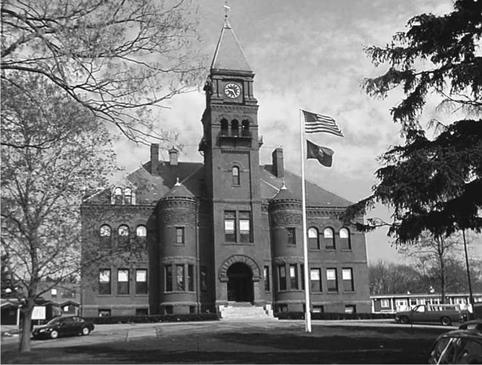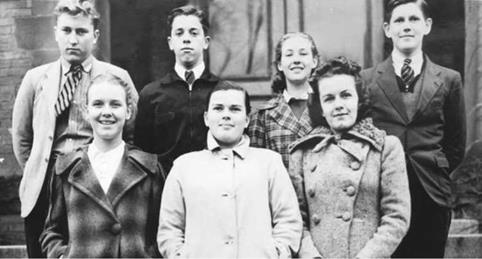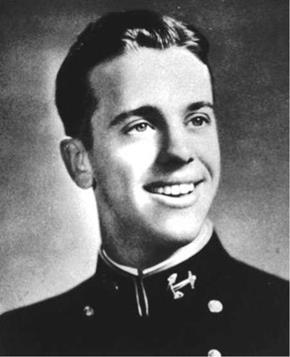THE URGE TO FLY
In his youth, Shepard developed a fascination with flying. One momentous day the family flew to Boston from Grenier Field, an Army Air Force base in Manchester. From then on he began haunting the airfield, about eight miles from home, watching airplanes take off and land, and later doing small helpful jobs around the hangars. He made dozens of model planes and read every book on flying that he could find, his favorite being a well-thumbed copy of Charles Lindbergh’s epic, We.
“He loved science, too,” his mother recalls. “Oh, and he had a boy-like interest in Buck Rogers and some of the science fiction. But in school he developed a serious interest in the subject and worked hard at it. He did extremely well in mathematics, and this helped him immensely.” [7]
After junior high, Shepard went on to get his secondary education at the Pinkerton Academy in Derry, where he would complete grades 9-12. Ivan Hackler, who taught Shepard, recalled that his student had a keen interest in science as a youngster. “A good student and a boy extremely well-liked,” Hackler said. “He was a good athlete, particularly in baseball and football.” [8]
|
A recent photo of Pinkerton Academy. (Photo courtesy of Brian Chirichiello) |
Outside of school hours, Shepard would deliver newspapers on his bicycle and attend Sunday school at the East Derry church, where his father was the organist.
“I was raised, if not exactly in an atmosphere of aviation, at least in the midst of mechanical things,” he revealed in the Mercury astronauts’ book, We Seven. “I had a five-horsepower outboard motor which I used to take apart and put back together again. And I often helped my father when he had things to tinker with – as you usually do in a small farming town. When I was in high school, a friend of mine and I used to cycle out to the airport… and do odd jobs around the hangar in exchange for a chance to take rides in an airplane now and then.” [9]
From East Derry he went to school for the next year at the Admiral Farragut Academy in Toms River, New Jersey, specifically to help prepare for enrollment at the U. S. Naval Academy at Annapolis. He took with him a letter from his Pinkerton history teacher which spoke of his “good abilities” and “qualities of leadership.” The Farragut records reveal that Shepard had a genius level IQ of 145, as proved by his solid marks in geometry and mathematics, but he did tend to lag a little in English. Noting this, his father wrote to the academy, suggesting he would appreciate it if a little more pressure could be placed on his son to do more studying. This obviously
|
Alan Shepard second from left in back row, taken at Pinkerton Academy in 1938. (Photo: Shepard family) |
worked, as Shepard passed the entrance exam the following year at Annapolis with a 3.7 in math and a 3.3 in English out of possible perfect scores of 4. The Farragut Academy year-book recorded of him, “he speaks words of truth and soberness.” [10]
He entered the Naval Academy as a 17-year-old “plebe” in 1941 and was whisked through the school at the wartime-accelerated pace, graduating with his bachelor of science degree a year earlier than the normal four-year term in 1944. The Academy’s Professor George Beneze remembers Shepard for having a keen interest in aviation, pursuing associated subjects such as internal combustion and thermodynamics with zeal. “He asked a lot of questions, and was interested in what was going on in the laboratory,” Beneze said. “You could depend on him.” Classmates of Shepard at the Academy recall him as being energetic and aggressive. Among other activities, he rowed on the varsity crew in the bow seat. The story is that the coaches wanted to move him from that position because he was too light, but Shepard refused to move, declaring, ‘I want to be first.’” [11]
On 3 March 1945 he married Louise Brewer, whom he had met while attending the Naval Academy. They would eventually have two daughters Laura and Julie, and also raise a niece, Alice, as part of their family.
“The Navy had a rule that even prospective flyers had to go to sea first,” Shepard reflected, “so I spent some time on a destroyer [USS Cogswell (DD-651)] in the Pacific during the closing days of World War II. I took flight training at the Navy schools at Corpus Christi and Pensacola, Florida. Then I served in a fighter squadron that was based at Norfolk and made two cruises aboard carriers in the Mediterranean during 1948 and 1949.
“My flying career really got going in 1950 when I was still a lieutenant, junior grade, and was lucky enough to be chosen to attend the Navy Test Pilot School at Patuxent River. This was a real plum, especially for a junior officer.” [12]
|
Alan Shepard as a U. S. Naval Academy “plebe.” (Photo: USNA) |
His parents were delighted with their son’s latest achievement, as his mother Renza declared in a 1962 interview. “After Alan went on to the Naval Academy and took up the career of his dreams – being a pilot – he still missed his lovely New Hampshire. Many times he’d fly home, if only for a day. Sometimes he wouldn’t be able to stop and see us, but he would buzz the house in his Navy fighter and we’d know who it was!” [13]
After graduating from Test Pilot School, Shepard stayed on at the Patuxent River Naval Air Station for a further two years, testing and aiding in the development of a number of highly powered Navy aircraft, such as the F-3H Demon, F-8U Crusader, F-4D Skyray, and F-11F Tigercat. A skilled pilot, he took over as Project Test Pilot on the F-5D Skylancer.
Among his many achievements as a Navy test pilot, Shepard says he “helped to develop the Navy’s in-flight refueling system and was involved in testing the first angled deck on a U. S. Navy carrier… I was operations officer for a while in a night – fighter squadron that operated off the West Coast, and served aboard a carrier in the Pacific from 1953 to 1956.” [14]
In 1958, following more flight-test and instruction work at Patuxent River, he was assigned to the Naval War College of Newport, Rhode Island in order to brush up on a number of academic subjects. Next, Shepard joined the staff of the Commander in Chief, Atlantic Fleet, as aircraft readiness officer.
The following year, an opportunity came his way that he found hard to resist. He had read articles on NASA’s space program in newspapers and knew that the space agency would soon be recruiting a cadre of test pilots that they had begun calling “astronauts”, meaning voyagers to the stars. Shepard knew that aviation was coming to an inevitable crossroad and space flight was the way of the future. He felt it would give him the chance not only to be regarded as a top pilot, but also as a space pilot, or astronaut. He was certainly qualified from all that he had read, and was ready to be called.
“I assumed they’d probably be looking me up and asking me if I was interested. As it turned out, they were doing just that. But the orders got misplaced somewhere – they wound up on someone else’s desk for a few days – and I was beginning to wonder if I had been overlooked or disqualified. The orders finally came asking me to report for the first briefings, and I was delighted. I had a long talk with my wife that night, discussing what I should do if I were selected. Finally, Louise said, ‘Why are you asking me? You know you will do it, anyway.’ Louise had always been in complete support of what I had done, and I knew she was behind me now.” [15]













